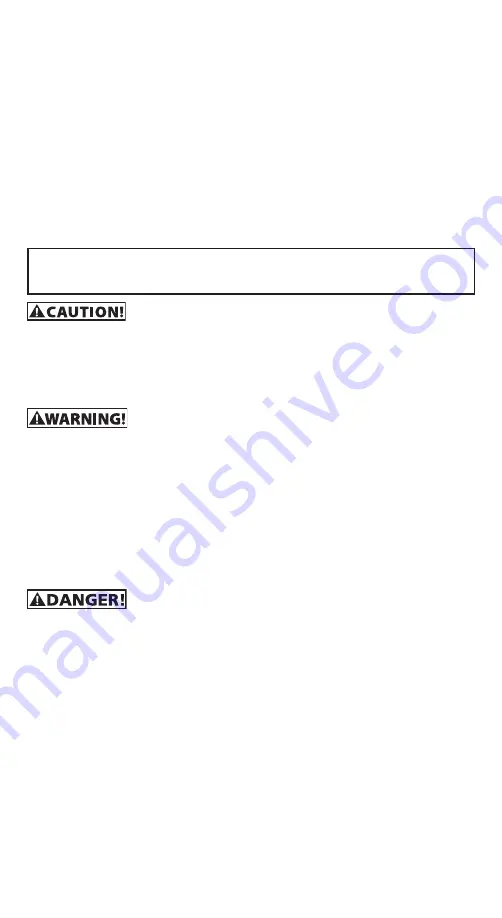
THIS SMOKE ALARM WILL NOT WORK WITHOUT 120 VAC POWER AND A
GOOD BATTERY PROPERLY INSTALLED. THE SMOKE ALARM SHOULD BE
TESTED WHEN INSTALLED AND THEN TESTED WEEKLY AFTER THAT.
ELECTRICAL SHOCK HAZARD
Turn off power to the area where you will install this alarm at the circuit breaker or fuse box
before beginning installation. Failure to turn off the power before installation may result in
serious electrical shock, injury or death.
CAUTION: THIS SMOKE ALARM IS SEALED. THE COVER IS NOT REMOVABLE
!
• A mounting bracket is provided on the back of the alarm.
• Remove the mounting bracket from the back of the alarm by holding the mounting bracket and
twisting the alarm in the direction indicated by the "TWIST TO REMOVE" arrow on the side of
the alarm base.
OPTIONAL TAMPER RESISTANT FEATURES:
There are two separate tamper resistant locking
features provided for this model. Activating one or both of these features deters someone from
removing the smoke alarm from the mounting bracket or removing the battery from the alarm. The
breakaway locking pins are clearly marked and molded into the mounting bracket. Refer to the
diagram on the next page.
TO ACTIVATE THE LOCKING FEATURES:
Do not activate the locking features until you have
activated the battery, mounted the smoke alarm to the bracket and tested the smoke alarm. Refer
to OPERATION, TESTING & MAINTENANCE instructions on Page 6.
1. Detach the breakaway alarm locking pin from the mounting bracket.
AVOID THESE LOCATIONS
• the garage – products of combustion are produced when you start your vehicle.
• near appliances or areas where normal combustion regularly occurs (kitchens, near furnaces,
gas hot water heaters). Use smoke alarms with photoelectric sensors or smoke alarms with
Silence Feature for these areas.
• in areas with high humidity, like bathrooms or areas near dishwashers or washing machines.
Install at least 3 feet (0.9 meters) away from these areas.
• in areas of turbulent air such as air returns or heating and cooling supply vents, smoke alarms
shall not be located where airflow prevents smoke from reaching the alarms.
• in extremely dusty, dirty or insect-infested areas. Loose particles interfere with smoke alarm
operation.
• in areas where temperature may fall below 40
0
F (4.4
0
C) or rise above 100
0
F (37.8
0
C).
• closer than 1 foot (0.3m) from fluorescent lights, electrical "noise" and flickering may affect the
alarm's operation.
• closer than 3 feet (0.9m) horizontal path from the tip of the blade of a ceiling suspended (paddle)
fan.
• on a poorly insulated ceiling or exterior wall (mount smoke alarm on an inside wall).
Page 4
Early warning fire detection is best achieved by the installation of fire detection equipment
in all rooms and areas of the household as follows: A smoke alarm installed in each separate
sleeping area (in the vicinity of, but outside of, the bedrooms); and, as appropriate, heat
or smoke alarms in living rooms, dining rooms, kitchens, hallways, attics, furnace rooms,
closets, utility storage rooms, basements and attached garages. Test the alarms weekly to
assure proper operation.
INSTALLATION INSTRUCTIONS: CAUTION!! READ CAREFULLY.
Installation of this alarm must conform to the electrical codes in your area; In accordance
with CSA C22.1 Canadian Electrical Code, Part 1, Safety Standard for Electrical Installations,
and any other local or building codes that may apply. Wiring and installation must be
performed by a licensed electrician. Failure to follow these guidelines may result in injury
or property damage.
This alarm must be powered by a 24-hour, 120V AC 60Hz circuit. Be sure the circuit cannot
be turned off by a switch, dimmer or ground fault circuit interrupter. Failure to connect this
alarm to a 24-hour circuit may prevent it from providing constant protection.
IMPORTANT: Do not subject this smoke alarm to megger, high voltage or high-pot tests.
Remove the smoke alarm(s) before high-potting tests occur on the circuit or system.















